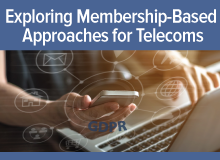 A membership approach can generate the highest level of emotional engagement. ‘Members’ feel that they are part of a group defined by the telco.
A membership approach can generate the highest level of emotional engagement. ‘Members’ feel that they are part of a group defined by the telco.
Did you know that ‘Belongingness’ is a word? It describes our emotional need to be an accepted member of a group, to belong to something bigger than ourselves. For many people, it’s an itch that needs scratching. The question is – could telecommunication service providers respond to that itch? And if they did, how could it help their business?
‘Belongingness’ approaches are still relatively uncommon in the telecommunications industry – and they won’t be appropriate for every service provider.
Companies whose business model is rooted in simple price and feature-based competition may not see value in applying such concepts to their business. But others may see things differently, recognizing that greater share of wallet, and better Net Promoter and customer satisfaction scores increasingly depend on more than prices and features.
They have come to realize that part of their value could be in creating a sense of ‘belonging’ – and that’s where membership- and community-based approaches can come into play.
How an individual is treated has a huge bearing on their emotional closeness to the brand. People mirror the emotions that are shown towards them, and individuals will reflect the attitudes that telcos show towards them as a collective.
If people are treated as subscribers, their emotional connection with the service provider is likely to be very low. The relationship will be largely uni-directional, within which the operator provides services to the subscriber and hopes they will keep generating revenue.
If the individual is treated as a customer, the relationship has more emotional elements. The operator will listen to customer feedback, and the customer may come to feel some level of association to the brand – but is unlikely to broadcast about it.
A membership approach can generate the highest level of emotional engagement. ‘Members’ feel that they are part of a group defined by the telco. They are more likely to be brand advocates and to drive business to the company.
Membership-based approaches, while not yet widely adopted, are not new to the telecom industry.
British MVNO GiffGaff is already well-known for its community-based business, where anyone can become a member by purchasing their products. Its brand promise is: “Become a GiffGaff member and join our network where members are in control.”
This control requires no contracts, but allows members to change their plan every month and to be part of the GiffGaff community. Helen Mannion, Head of Business Intelligence at GiffGaff, explains “We want to listen, we want to collaborate, and we want to create mutual benefits. We are rooted in community and mutuality”.
This approach has worked well for GiffGaff as a business. Their members clearly value connection with the community – not just GiffGaff’s prices and product features.
Other examples can be found the industry too. O2 Priority in the United Kingdom and 3Plus in Ireland make their members feel special and privileged through exclusive access to benefits – for example, to major live events with priority access tickets.
These two membership approaches are very different. The community approach is slower to start and harder to keep running. The upside is that it is much harder to copy than the exclusive benefits approach. O2 Priority and 3Plus are effectively the same proposition (though in different markets), and other service providers could quite easily build or lease arenas and start offering exclusive events.
Would a membership-based approach work for your business? There are several considerations. Would your customers respond well to a sense of belonging? Does it fit with the business model of the company and the strategy, whether that is to be a simple low-cost service provider, or to be to be a highly differentiated leader in the market for customer value?
‘Belonging’ is a concept that any service provider that cares about their customers and the sustainability of their business should explore. It can help the business gain access to customers’ thoughts about their products and services (‘members’ are much more willing to give ideas and feedback than subscribers). It can save money by connecting customers with each other for mutual (and very low cost) customer service. And it can greatly strengthen customer loyalty and affinity, driving more sales through higher Net Promoter and customer satisfaction scores.
Ensuring the highest possible customer relevancy and personalization is important in membership, and using all the data available in the ecosystem is vital for that. Managing data efficiently and delivering it to the member in an engaging way will help create successful memberships and business outcomes.



